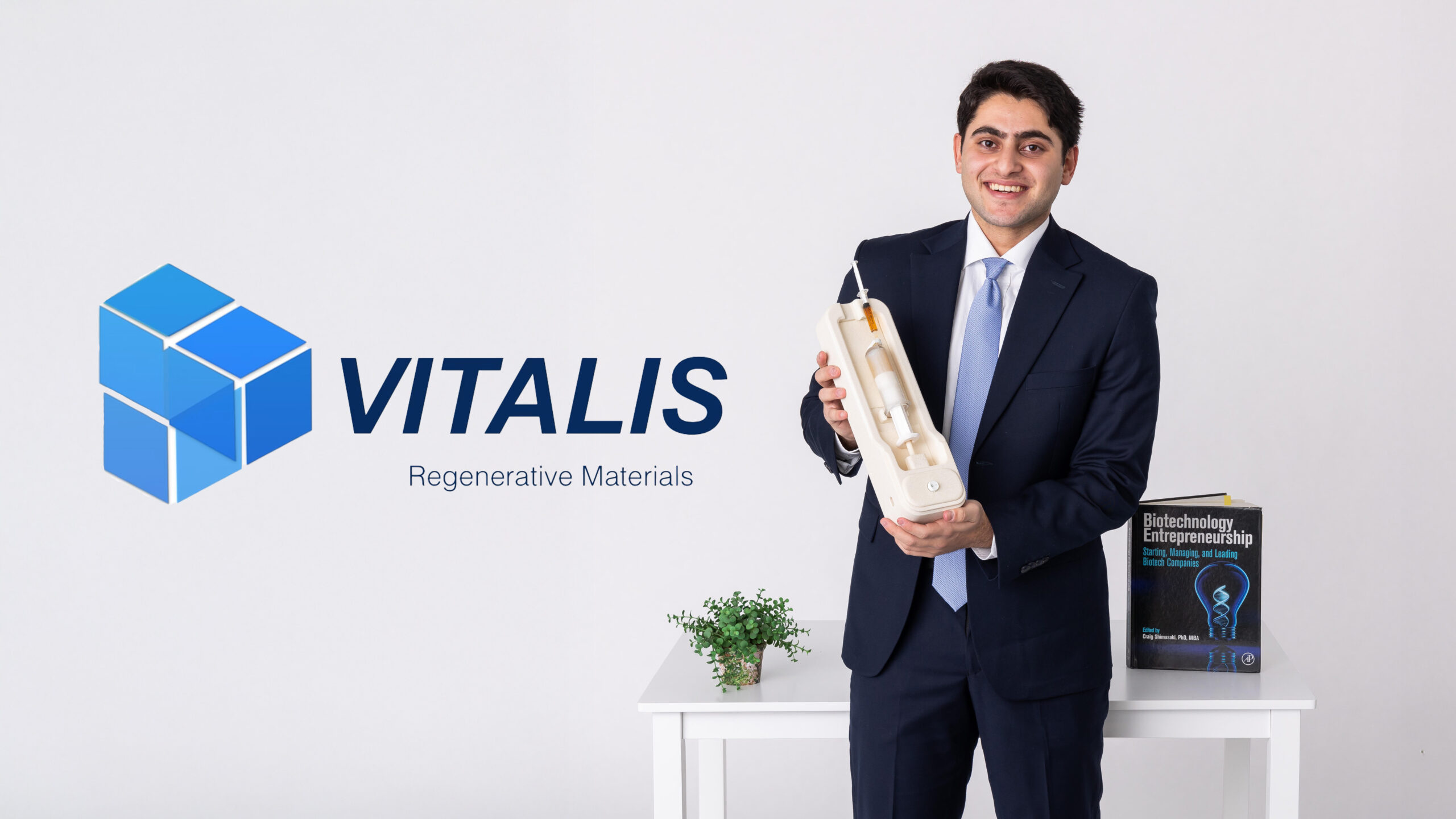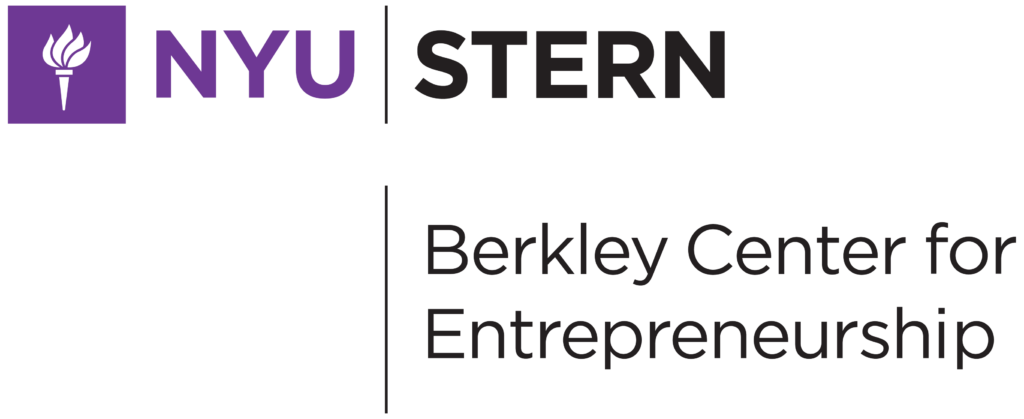
Revolutionizing Recovery with Vitalis Regenerative Materials
Team: Asser Elashwah, Tandon B.A./B.S. ’26
About the Venture: Vitalis transforms surgical outcomes with BioBlend—a revolutionary bio-integrated tool that enhances tissue regeneration and reduces complications in sports medicine procedures.
Q: What problem does Vitalis Regenerative Materials aim to solve?
Being the sole founder, I was always drawn to innovation, especially in biomedical engineering. I came to NYU Tandon as a pre-med student studying biomolecular science, fueled by a dream of becoming a surgeon. But I knew early on that I didn’t just want to study medicine—I wanted to build something real, something I could one day use in the operating room.
While I initially aspired to become a surgeon, my hands-on hobbies like woodcarving and painting sparked a love for creating. This passion led me to bioengineering, where I could design transformative tools to advance surgical practices. Vitalis embodies this vision—developing biomaterials and tissue engineering solutions that enhance healing and seamlessly integrate into surgeries.
My journey into biotechnology truly began when I spoke to a friend who had helped start a biomaterials company. That conversation opened my eyes to the potential of natural polymers and how they could be tailored for medical applications. It was like everything clicked—I knew I wanted to combine my love of surgery with my passion for biomaterials and design how they are delivered. That’s when Vitalis was born—a vision of making advanced regenerative tools that feel like a natural extension of the body, giving surgeons more than just a mechanical fix but a way to truly promote healing. It’s been a relentless pursuit ever since—building, testing, learning, and reaching out to anyone who might help make this vision a reality. It’s not always easy, but it’s worth every effort because I believe in it, and I know there’s a better way to heal.
Q: What inspired you to take this step into entrepreneurship?
My passion for entrepreneurship goes way back. As a kid, I sold squishy stress balls made from balloons filled with flour. In high school, I developed a smart wearable watch—similar to Whoop—before it even hit the market. I’ve always known I wanted to build technology that made a real impact, but I didn’t always know what that would look like or which market it would serve.
Things started to click when I took the Engineering Innovation class under Professor David Lefer. It wasn’t just inspiring—it gave me a blueprint for how to turn ideas into ventures. A friend who had been a TA for the class and later became a successful entrepreneur encouraged me to get involved as a TA myself. That experience exposed me to the startup ecosystem at NYU and in New York City, and it grounded me in the principles of the lean startup method.
From there, I immersed myself in the field, taking countless advanced courses in tissue engineering, natural polymers, and stem cells—way beyond my major requirements. I wanted to understand the landscape at the highest level and see what worked and why. One day, while in a computer science lab, I was talking with a friend about using biomaterials to heal during surgery. I remember that conversation sparked the initial idea, even though I didn’t know exactly how or who it would serve at the time.
Q: What sets you apart from what’s on the market right now?
What truly sets Vitalis apart is our real-time delivery mechanism that combines advanced biomaterial formulations with PRP directly at the point of care. Unlike conventional PRP therapies, which rapidly dissipate and lose effectiveness, our device allows the PRP Polymer created to maintin a sustained release of growth factors through a biocompatible polymer formulation I created. This synergy supercharges PRP’s healing potential, transforming it from a post-surgical injection into a dynamic biosurgical tool. By offering surgeons a product that seamlessly integrates into their existing workflow and protocals to enhances tissue regeneration during surgery, we are setting a new standard for regenerative medicine in the operating room.
Q: What motivated you to apply to the NYU Entrepreneurs Challenge?
Applying to the NYU Entrepreneurs Challenge felt like a natural step—almost like a rite of passage for a startup like mine. It’s one of those places where innovation, ambition, and opportunity come together. I knew that being part of it would mean more than just competing; it would mean surrounding myself with like-minded individuals, mentors, and experts who could push me to think differently and refine every aspect of my venture.
The challenge is a hallmark of NYU’s startup ecosystem, and I wanted to immerse myself in that environment—to learn from others, get constructive feedback, and make real connections. Plus, let’s be honest—the prize money would make a huge difference in moving things forward, helping me overcome some of the biggest barriers to commercialization. More than anything, though, I’m here to grow, learn, and prove that this idea has what it takes to make a real impact.
Q: What has been the biggest turning point for you in your startup journey?
I think the biggest turning point for me has been realizing that not having money, an established lab, or advanced equipment is actually a blessing. So many people fixate on doing something only once they have funding or someone gives them the green light. But that’s not how it works—you just have to make it happen. Leverage the fact that you have nothing and no one believing in you to come up with the most outlandish solutions. Being so constrained forces you to think differently—it breeds innovation.
Simply having a new material or chemical composition isn’t enough to compete or show significant results. It’s about understanding the landscape of the market—what’s already out there, what’s missing, and how we can build on existing work to create something better. That mindset shift was huge for me. I used to think that developing one great experiment or producing impressive research was the key. But the reality is that great papers don’t directly translate to products or a business. It’s about figuring out how, in a field as nuanced as this one, I could use the least amount of technological maturity while proving value and targeting a specific market segment in a new way.
It’s also about constantly asking yourself: Why does this venture exist? What’s our purpose in the world? Where do we fit into procedures, with which doctors, for which patients—especially in a multi-tiered market like healthcare? You can’t afford to lose sight of that bigger picture, no matter how tough it gets or how technical the work becomes.
Q: What have been the biggest challenges you’ve faced so far in building your startup, and how have you overcome them?
The biggest challenge is everything. Being a solo founder is tough but not impossible. You have to design prototypes, interact with customers, figure out a sustainable business model, and convince people to invest in you and your vision—all while managing schoolwork, and other commitments, long nights, and stress and adrenaline go a long way but they are not sustainable. It’s an insane task, but again, not impossible.
Figuring out how to really start is the hardest, yet coolest and exciting part, especially in a field like this. You might have a good idea, but how do you test it? How do you research, develop, and find its fit in the market while constantly iterating? People will close doors in your face, not take you seriously, and refuse to help—but that’s all part of the process. The more you chip away, the clearer it gets.
Some might think it’s just luck, but it’s really about preparation meeting opportunity. You have to stay resilient, keep pushing, and never lose sight of the vision. That’s the sweet spot where hard work and readiness come together to create success.
Q: What are some recent milestones you have achieved/or are working towards? How has it been reaching them?
Recent milestones I have achieved are rooted in our development goals. Consistently building high-fidelity prototypes that make the concept tangible and real for customers to interact with. Increasing outreach to the medical community has been crucial as well—engaging with end users to gauge their interest, ensuring they find value in using the product, and making sure they feel comfortable and confident with it. At the same time, we’re focused on proving results to patients and demonstrating clinical relevance.
Currently, we’re working toward patentability, running small-scale animal studies to validate efficacy, and building up a base of surgeons as early adopters for continued interaction and potential pilot programs. It’s all about creating a strong foundation while fostering connections with the medical community to ensure seamless integration into real-world practices, building up the backend, so that it’s as accessible and user friendly and effective as possible.
Q: What advice would you give to aspiring entrepreneurs, especially those just starting out?
You don’t need to have it all figured out from the start, but you do need to be adaptable. Start small, think big, and move fast. Use the least amount of technology to prove your concept—then see if anyone cares. You need to be a little delusional, believing your startup’s existence is essential to your survival. It has to become a living part of you—something you practice like training for a season of games. Study the competition, make game plans, and learn from your losses. There’s no sprint or million-dollar check waiting; it’s about getting comfortable with the journey because that’s what sets you apart from everyone else who isn’t taking this risk.
You’re the only one building this, so you are the expert. Know your story—how it’s made, who uses it, and why. Stick to your key principles and keep asking “why” to rationalize every decision. When stuck, revisit your core ideas, take a break, or clear your mind. You need to be both your strongest cheerleader and toughest critic. Be intentional with every word, every design, and every milestone. Stay relentless, driven, and never lose sight of the bigger picture.

